For the next week, we planned to slow down and take a break from hosting mode, as we made our way by ourselves south to Cavtat to pickup our kids. In the last few weeks in Croatia, we had been forced to skip several interesting islands due to the weather or schedule challenges. We now finally had a chance to check these places out before we said goodbye completely to this country of countless islands.
Bidding adieu to Emmy, Graham and Sarah, we set off from Murter with the eagerness of seeing new places, while re-visiting some of our favorites. As we entered our fifth week in Croatia, we were starting to gain the comfort and confidence that comes with prior knowledge of these waters. No longer were we shuffling through pages in a cruising guide on a cold wintry night; we had zig-zagged our way through these long, skinny islands on our own craft, faced a fair balance of adventure and adversity, and were still married happily enough to want to spend another week alone together!
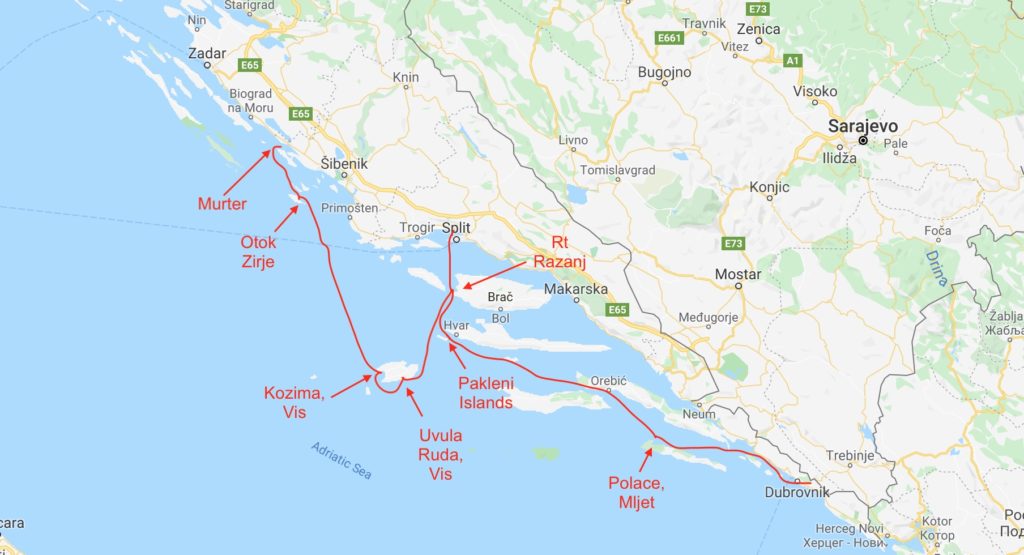
We chose a short sail away from Murter, landing at the nondescript island of Otok Zirje. There was nothing written about this island in the cruising guide, and not much more in the crowd-sourced boating app Navily. The eastern side, protected from the winds, only had a few coves that would work for an overnight and they were microscopic enough to only be suitable for one boat each. The first cove looked promising until we rounded the point and saw a mast, then the full boat, nestled into the crutch of the V-shaped indentation, happily tied bow and stern and casting us a glance that needed no translation – ‘we sure hope you move along!’ Option #2 was thankfully slightly larger, enough to accommodate an existing small cabin cruiser, a family onboard a catamaran, and us. We staked our claim, setting our bow anchor and running a stern line ashore. We tried moments later to hide our pleasure when both of the other boats abruptly left. We both love to explore big cities, but at the same time, having a little cove all to your self for the night sounded pretty sweet. We immediately jumped in the water for a snorkel, which proved to be a bit of a killjoy. The sea floor here was literally littered with the excesses of mankind. Rubber tires, plastic signs, glass bottles and beer cans, buckets, and carelessly discarded remnants of fish netting. We were no longer in one of the admirably clean national park anchorages. This was an atypically free anchorage. Is this what happens when boaters aren’t required to spend the 100-300 euros per night to anchor at a national park? A new face of Croatia was emerging, and I was trying, like a child holding their palms to their ears, to not let it in to my conscience. Swimming to the small beach at the head of the cove, the pain only increased. It was like the end of funnel, with all the detritus arriving by whatever means along this cove’s wide-open arms, concentrating the debris at this epicenter of a beach. Mounds of plastic, churned up by past storms into unidentifiable chunks, had been piled high where you would normally hope for sand. Images of the infamous ‘crying Indian’ commercial flashed through my mind. It was an apt reminder to watch our own garbage, and to stop complaining about the high cost of National Park moorings!
After a blissfully longer sleep than normal, as residual fatigue from the Code 0 fiasco lingered, we raised anchor and got swiftly underway for a 40 mile passage to the island of Vis, one of the spots we had to skip in the previous weeks. The prevailing NW winds would have been ideal for this passage, but as luck would have it, we had to beat to windward in southerlies. Vis stands proudly offshore of the other well-known Croatian islands, almost like it is saying, ‘sail out to me if you dare!’ By late afternoon, we turned around the western tip of Vis and entered the harbor of Kozima, noting a plentiful number of other sailboats doing the same thing. While Kozima is a large harbor, the shallow depths ideal to anchor in are all occupied by mooring buoys, with the only other option to go stern to the small breakwater. As we approached, masts filled the viewfinder on my binoculars. Docking at the breakwater was out of the question, and as best I could tell only a few mooring buoys were still available. One boat behind us revved their motor up a like a Dale Earnhardt wannabe, catching the attention of the mooring skiff before we could and snagging the last mooring inside the breakwater. It took all of the California beach boy I could muster inside me to calm the New Yorker at the helm. We were soon directed to the overflow parking lot of sorts, taking up a mooring on the outside of the harbor.
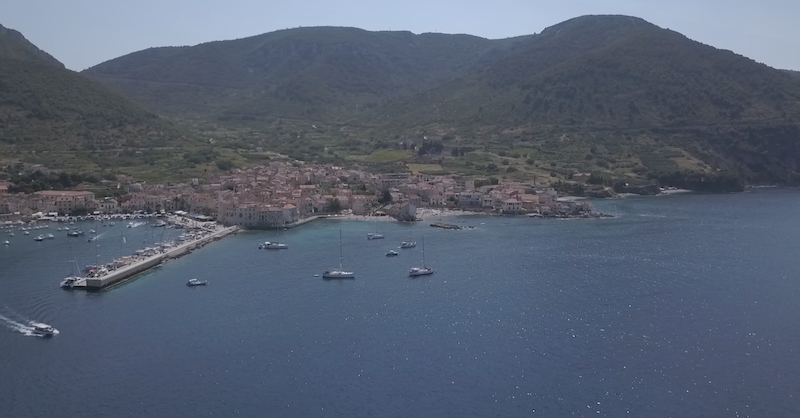
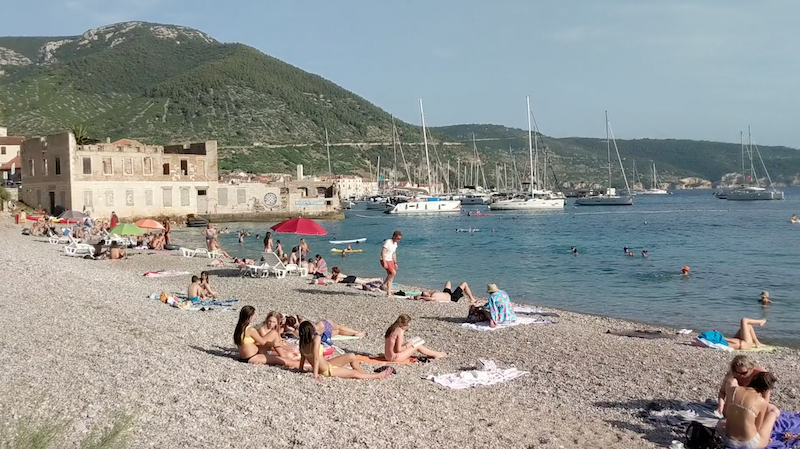
Making our way in the dinghy ashore, the harbor is a zoo of big and little boats – quite the opposite of last night’s anchorage. Vis was only opened to tourists in 1989, and it seemed like it was making up for lost time. We dodged beachgoers and kids in strollers as we did our own strolling of the narrow streets. For many years, Kozima had supported a very prosperous fishing industry, prosperous enough for the pirates of yore to attack their boats and make their captains galley slaves. The Venetians, who ruled the island, and much of this area of the Med, finally agreed to step in and fortify the city. We chose to fortify ourselves with a carafe of the local wine and a plate of cheese at a waterfront cafe before retiring back onboard Sea Rose.

At 1 am, and wondering why all bad things seem to happen after midnight, we both awoke to the sound of wind in the rigging. Dark clouds at dusk had foretold the arrival of a storm, so we weren’t completely caught off guard; but regardless, we stood watch in the cockpit to see how we swung on the mooring buoy relative to the boats nearby. Abruptly, the wind shifted direction, and a large catamaran next to us swung around and nearly struck our stern. I could see the dark silhouette of a person on the front trampoline, and presuming it was the captain of a charter boat, I asked him to please take up on the large amount of slack in his bow lines. Many of these mooring fields were laid out when the typical cruising boat was much smaller. Now, especially with large catamarans with tall sides to their hulls which act like mini sails sending them careening back and forth on a mooring, it was particularly important to pull the mooring lines tight. This captain, like many we were getting used to in Croatia, seemed unfazed and, more concerning, unwilling to help. I was told ‘That is just the way the moorings are’, followed by ‘put out more fenders.’ Now, for a role reversal, my New York wife had to calm me down. Our lamaze classes had been too long ago to help. I would have had to buy up the country-wide inventory of fenders to protect us from the razor sharp dual bows of his gigantic house-on-the-water. If I had a sling shot, it could have been a David and Goliath reenactment. He returned to his cozy cabin while I stood watch for another hour, ready to demand insurance details if he struck us, until the wind died down. He was gone before daybreak, denying me the opportunity for a good yell across the water. My parents raised me to be reserved, but it would have certainly felt awesome to get the frustration off my chest!
The mass of boats arriving yesterday afternoon into Kozima were now all heading out, along with many fast inflatable tour boats, aiming for the popular Blue Cave on the adjacent island of Bisevo. Every country around here seems to have their own blue cave, and we had already seen several, so we opted to explore along the southern coast of Vis, dotted with small coves and less nerve-racking options for overnight anchoring. We had fun poking into each one to check it out and discuss the relative merits of each. The sun was out, the winds were light and the cliff-side scenery was pure eye candy.
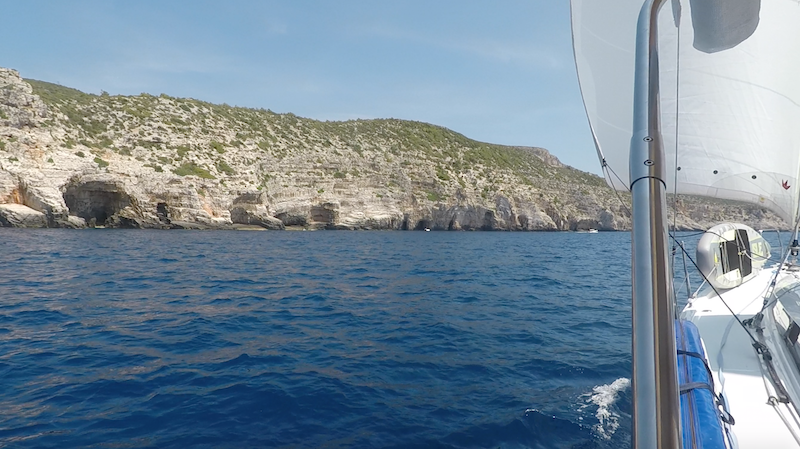
We settled on Uvula Ruda, a horseshoe shaped cove with room for a handful of boats. Lucky for us, another sailboat was just leaving and we went stern to in their spot, setting the anchor easily in the sandy bottom while running two stern lines ashore in the favored V configuration. The forecast was for more high winds and possibly a few thunderstorms overnight, so we pulled in our bow and stern lines tight as guitar strings ready to face whatever Mother Nature could throw at us. While I was ashore tying off the stern lines to prominent round rocks, I had dove back into the water with my mask on, which had the effect of pressing hard against my face. I felt a slight bit of pain from the impact, but thought nothing of it until I was back onboard Sea Rose and moments later started to see unnatural shapes in my left eye. I blinked a couple of times, thinking it was some kind of floater that had come from the seawater. But this was different. It was as if someone had dropped ink into a bowl of water and the ink was stretching out across my vision in wispy strands, reminding me of the scene in Harry Potter, with Dumbledore and the Pensieve. Each time I would blink, hoping it would go away, more ink would disperse across my eye. Concerned, I called for Karen and told her I was wondering if I was having retinal detachment, something I was genetically more prone to, with my brother having dealt with it in both of his eyes. We were no where near civilization, tucked as we were in this small cove for the impending storms. I called and luckily got my brother on the phone. All of my symptoms matched with his retinal detachment. My racing heart beat didn’t help. We figured our best option was to high-tail it to Split, about 8 hours away. We dropped our preciously secure stern lines and raised the anchor at 4pm, thinking we could get to Split by roughly midnight if all 57 horses down below cooperated. Soon, Karen remembered that she had a Croatian friend from Meltwater that used to live in Split. Through several handoffs, she was able to make contact and found out that her friend’s cousin was married to an optometrist in Croatia, and just so happened to know of a very good eye clinic in Split. At the same time, my brother, bless his soul, had been on the phone with the retinal specialist in California that had done both of his eyes, and this doctor had found the names of two retinal specialists in Croatia’s capital city of Zagreb. In addition, I was successful in reaching my regular eye doctor back home, who said that the next 24 hours were critical and I needed to get myself into a local optometrist without delay. I was checking the Yanmar manual (our diesel engine) to see if they by chance had sold us 57 of their finest thoroughbreds. Fuel economy was of no concern. As the light started to fade, I was able to reach Svjetlost Klinika on the phone and make an appointment for noon the next day, the earliest they were to open. With this new timing, we decided it would be unsafe to approach the busy port of Split at night, and opted to anchor at Rt Razanj, on the northern tip of Brac, before nightfall. There was barely enough room for one boat, and we tried our best to tie a stern line ashore, but it didn’t compare at all to the secure anchorage we had created back on Vis. The arc of the nearby lighthouse’s beam was some comfort as we settled down in our berth, knowing that we’d need to get underway very early in the morning. Still, my mind was racing with scenario planning – how would we get to Zagreb for surgery, where would we leave the boat, could I trust doctors in Croatia with something so critical as my vision.
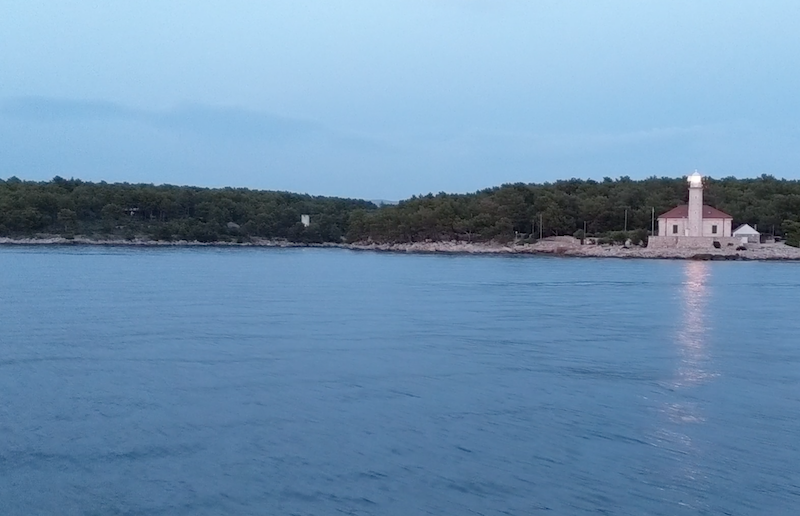
As if on cue, at 1 am the wind started to build and whistle through the rigging. I went up on deck and shined the spotlight on the rocky shore just downwind from us to see how our stern line was fairing. It had gone slack as Sea Rose pulled hard at the anchor line. We were without question getting closer to the limestone, sharp-as-a-butcher-knife rocks so common on these shores. Our depth alarm continued to go off, making it clear we had to move. I tied a fender to the end of the stern line and tossed it in the water, half wondering if we would ever see it again. Crises, for better or worse, make you focus like a laser on the problem at hand, dismissing everything else, like the cost of lost stern lines, fenders, or sails.
Rain was now being joined by lighting in the distance. This was the kind of pelting rain that feels like a shower of marbles – not the kind that drives you to sing and dance under a fancy umbrella for a Hollywood movie. We had the anchor up in an instant and started motoring out into the channel between Brac and neighboring Solta. This channel is very narrow and unfortunately the main passage for all of the ferry and ship traffic coming and going from Split. We turned on the radar, and watching like a hawk over the chart plotter screen for any AIS targets. Rain plays havoc with radar, causing the equivalent of static on the screen, blocking one’s ability to identify any valid targets. With heavily reduced visibility, it would be nearly impossible to see the lights of any craft with our own eyes. AIS was our only option. A large ferry was approaching us in the channel and we diverted north out of its way. But time moves slowly in these situations and it was hard to tell if the other captain was holding their course or diverting in a way that would collide with us. Once we felt like we were sufficiently out of their way, we slowed to a near stop. Rain was coming down in buckets, and lighting was striking all around us. We were clearly in the middle of the storm now. We were towing the dinghy and it was quickly filling with water, demanding our attention. I pulled the plug and we lifted the bow partially out of the water to drain it. Once it was nearly empty, we could hoist it fully on the davits. Frantically, we started searching for a better harbor that we could anchor in. We found a possible spot back on Brac, and further away from the crowded channel. The rain was starting to soften, and we were soon safely anchored in the lee of a small headland, protecting us from the residual wind. It was 3 am and we headed back down below for a couple more hours of sleep.
At the first signs of daybreak, we were up and raising anchor again. The skies were cloudy but otherwise benign. I was determined to rescue our fender and stern line, so we motored back to Rt Razanj. Hopping into the dinghy, I found the stern line easily, but the fender had apparently become untied and drifted off to neverland. We made a beeline for Split, tucking in behind a large city park and substantial headland to anchor near the Spinut Marina. We could not have asked for a nicer spot to anchor. Tons of room, no wind, shallow sandy bottom, and a marina to land our dinghy at. We caught an Uber to the eye clinic, and they had me in the exam chair shortly after 12:00. Being near-sighted most of my life, I have had my fair share of eye doctors. But this was a new and refreshing experience. First, all of the doctors and all but one of the staff were woman. Did we have to leave?! Second, it was one of the cleanest and most modern medical facilities I had ever visited. It’s hard to argue that the Europeans have the most stylish cars. Well, take note, the eye clinics in Croatia take top honors as well!
In the end, the clinic had diagnosed me with PVD – Posterior Vitreous Detachment – the much less dangerous stepchild of retinal detachment. It can happen as a part of normal aging of the eye, causing a gel to be released, explaining why I had felt I was in my very own Harry Potter movie. I would need to see my regular doctor in the next few weeks, which worked out perfectly with our planned flight home at the end of the month.
Breathing a huge sign of relief, and relaxing all afternoon back at the boat, I felt like a new man, with a new lease on life. I had passed go, collected my $200, and was ready to go around again! I was under doctor’s orders not to lift anything heavy, no jumping, and to generally take it easy. And even better, Karen was 100% onboard with this plan!
That night, like a broken record, the dark clouds arrived, following by rain and high winds. But we were dug in very well in sand, and had plenty of room to swing. No razor sharp rocks waited for us on the shore line. We slept like babies.

In the morning, we were underway in cloudy skies but just enough breeze for a gentle sail, allowing us to give our 57 thoroughbreds some time to rest. We retraced our steps back through the narrow channel between Brac and Solta, and found one anchorage amongst many in the salamander shaped Pakleni islands off the town of Hvar. It was time for a redux of our triangle shaped anchor position, as we cranked in tightly on our two stern lines, forming what I can only see in my head as the shape of the Gibson Flying V guitar, popularized by Tom Petty and many others. We took a low-key snorkel around the harbor, before turning in early for the night, as more high winds (do I sound like a broken record?) were forecasted to come at midnight. And sure enough, after midnight, the winds arrived with vengeance, this time competing with a local beach bar’s electro-disco style music, the kind that seem to be patented by European resort towns. This was the fourth night in a row of high winds. What happened to the placid Mediterranean summer conditions so talked about by other sailors?
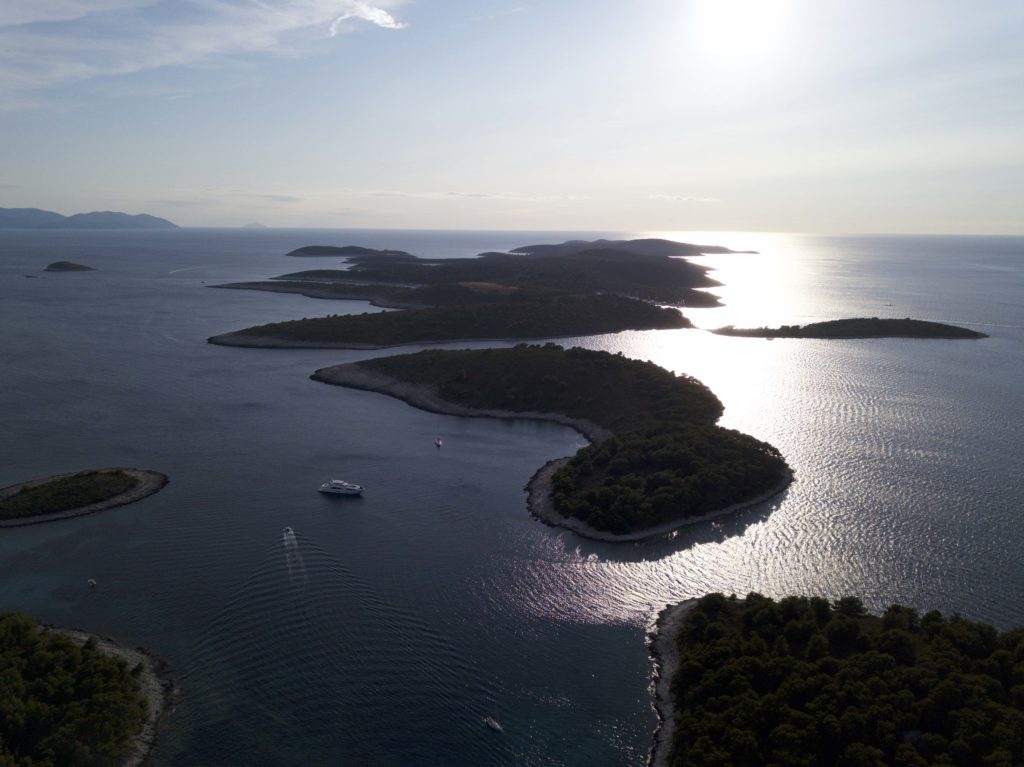

We were up early for the long run down to Mljet. The overnight storm clouds had ran away in hiding, leaving us with a beautifully clear day with copious amounts of sun and a pleasant absence of rain. We sailed gently past Korcula, and the crazy antics of the windsurfers and kite boarders. There was no ‘give way to the starboard vessel’ in these situations. You just hoped and prayed that at the speeds they were traveling, they could maneuver out of our way.
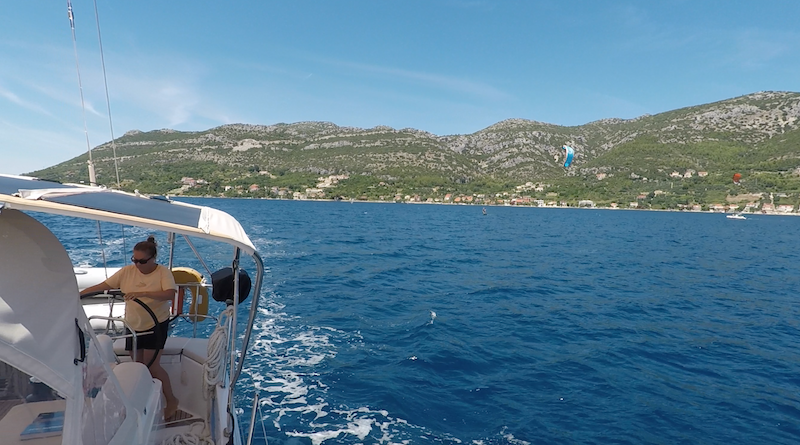
By late afternoon, we were motoring into the Mjlet harbor of Polace, feeling, on this second visit, a little like Norm taking his favorite seat in Cheers. We had called ahead to reserve the dock at our favorite restaurant Stella Maria and placed our order for the lamb ‘under-the-belle’. Ahh, the benefit of past experience. Walking through the ruins of the Roman palace, a distinguishing landmark for this town that already has much to offer, gave us a chance to soak up one more morsel of the incredible smorgasbord of history that awaits travels to the Med in particular and Europe in general. Soon enough, we would be back home in the Fall, in the most historically pervasive region of the United States, but with little comparison to the depth of these European treasures.
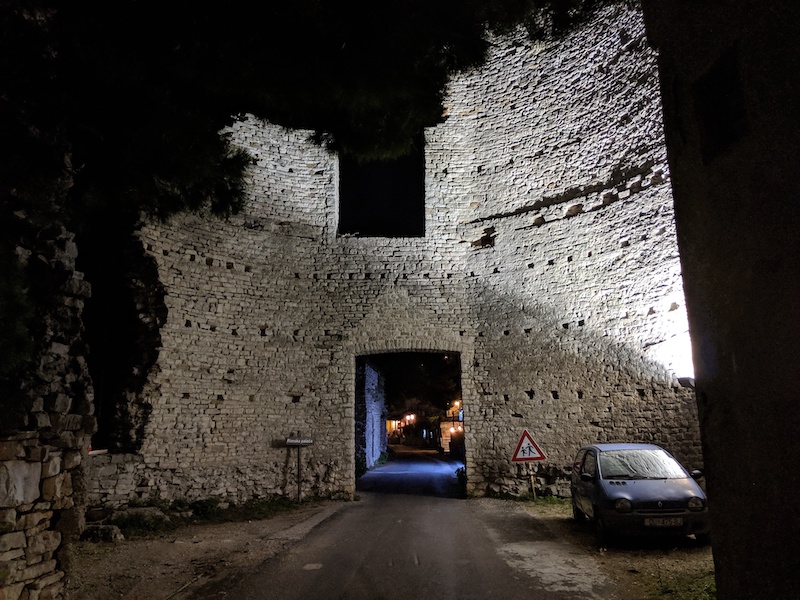
We are once again up early and on our way for the 30 mile run down to Dubrovnik. I’m hesitant to say anything for fear of a jinx, but it felt like the visits from the midnight winds were a thing of the past. The wind this morning was light and on our nose, so we were left with the motor to push us to our destination. Along the way, we checked out possible new islands and coves to visit with our kids when they boarded next week. Soon, we were motoring up the familiar Rijecka river to anchor in front of the ACI Dubrovnik marina, feeling like pros on this third visit. Except, this time, the river and marina was a zoo full of charter boats returning from their weekly charters. Clearly, we were no longer alone, as so many others were helping to make this the Croatian high season.
Catching up on the local news, we learned that the high winds, rain and lighting that had forced us to leave our anchorage in the middle of the night off Brac had blasted through the Kozima harbor on Vis with such ferociousness that several boats were torn from their moorings and at least two had been struck by lighting. In a way, it had been a blessing in disguise that I had the scare with my eye, forcing us as it did to leave prematurely from Vis. Any thought we had that the Code 0 blowout last week was an isolated incident had been quickly dismissed this week. Croatia was not a sailing destination for the faint of heart. Would our planned remainder of the summer in Greece be full of the angry side of Mother Nature too? We would have one more week in Croatia to see if she could show us her kinder side before we headed further south. Our fingers were crossed!

